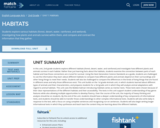
A.5d Graphing Systems of Linear Equations Co-Teaching MIP
- Subject:
- Algebra I & II
- Mathematics
- Special Education
- Material Type:
- Lesson Plan
- Provider:
- VDOE
- Author:
- VDOE
- Date Added:
- 10/07/2024

A.5d Graphing Systems of Linear Equations Co-Teaching MIP

Graphing systems of linear inequalities in two variablesMathematics Instructional Plans (MIPs) help teachers align instruction with the Mathematics Standards of Learning (SOL) by providing examples of how the knowledge, skills and processes found in the SOL and curriculum framework can be presented to students in the classroom.

AFDA Graphing Transformations Co-Teaching MIP

This lesson integrates computer science through discovering graphing on a coordinate plane for 6th graders all the way to a review for 8th graders with extensions that include slope.

In this assignment, students will spend time discussing the characteristics of weather and the importance of tracking weather and making predictions to be prepared, as well as graphing data.

Comparing and Ordering Numbers to 999Mathematics Instructional Plans (MIPs) help teachers align instruction with the Mathematics Standards of Learning (SOL) by providing examples of how the knowledge, skills and processes found in the SOL and curriculum framework can be presented to students in the classroom.

This lesson will help students understand that Greek mythology was based on a polytheistic religion that was integral to culture, politics, and art in ancient Greece. Students will see examples of Western civilization’s symbols, metaphors, words, and idealized images which come from ancient Greek mythology. The students will search for the names and area of influence for Greek gods and goddesses, and they will create a project which illustrates their understanding of the role of a Greek god or goddess. Students will need Chromebooks, Ipads or other devices by which they can access the Internet.

Using the Green Screen app, students will create short theatrical scenes to experience how Green Screens can be used to enhance a theatrical budget.

Investigating integers Mathematics Instructional Plans (MIPs) help teachers align instruction with the Mathematics Standards of Learning (SOL) by providing examples of how the knowledge, skills and processes found in the SOL and curriculum framework can be presented to students in the classroom.

Counting and writing numerals from 0 to 110Mathematics Instructional Plans (MIPs) help teachers align instruction with the Mathematics Standards of Learning (SOL) by providing examples of how the knowledge, skills and processes found in the SOL and curriculum framework can be presented to students in the classroom.

1.2a Grouping Tens and Ones Co-Teaching MIP

Counting and skip countingMathematics Instructional Plans (MIPs) help teachers align instruction with the Mathematics Standards of Learning (SOL) by providing examples of how the knowledge, skills and processes found in the SOL and curriculum framework can be presented to students in the classroom.

Counting and skip countingMathematics Instructional Plans (MIPs) help teachers align instruction with the Mathematics Standards of Learning (SOL) by providing examples of how the knowledge, skills and processes found in the SOL and curriculum framework can be presented to students in the classroom.

Students will be creating their own growing pattern using manipulatives, such as shapes, pattern blocks, or linking cubes. In creating their own growing pattern, students will debug to make sure that their growing pattern is correct. Students will also be given growing patterns with a mistake and they will have to debug to find the error and fix it.

The students will learn about growing patterns and how to connect this mathematical term to a warm-up in music.

Determining patterns created by counting by twos, fives, and tens on hundreds chart Mathematics Instructional Plans (MIPs) help teachers align instruction with the Mathematics Standards of Learning (SOL) by providing examples of how the knowledge, skills and processes found in the SOL and curriculum framework can be presented to students in the classroom.

Students will analyze groups of items and compare and contrast the attributes that led to the development of a group like living or nonliving and subsets like animals and plants. When categorizing attributes students must make observations of patterns, similarities, and differences in physical properties to further divide the group into subsets. In computer science, actions can be classified as algorithms. Students will use a dichotomous key to classify and place organisms into specific subsets within a pond ecosystem based on their physical attributes.

This analysis and discussion activity introduces students to the biology of HIV infection and treatment, including the molecular biology of the HIV virus life cycle and the importance of understanding molecular biology and natural selection for developing effective treatments. The questions in this activity challenge students to apply their understanding of basic molecular and cellular biology and natural selection and interpret the information presented in prose and diagrams in order to understand multiple aspects of the biology of HIV/AIDS and treatment.

In this unit second graders explore different habitats (forest, desert, water, rainforest, and wetland) and investigate how different plants and animals survive in each the habitat. Rather than just learning facts about the habitats, students examine come to understand the connection between parts of each habitat and how those connections are crucial for survival. Using the Next Generation Science Standards as a guide, students are challenged to use the information they learn about different habitats to compare how different plants and animals depend on their surroundings and other living things to meet their needs. Students will also be challenged to compare the differences in the kinds of living things that are found in different areas and why those differences exist. This unit builds on the first grade Animals unit, in which students learned about different types of animals and their characteristics, and prepares students for a third grade unit in which they will analyze animal adaptations with regard to animal habitats.
This unit uses the Bobbie Kalman Introducing Habitats series as mentor texts. These texts were chosen because of their clear representations of the different habitats and their accessibility. The texts in this unit support student understanding of key genre features while also allowing multiple opportunities to develop fluency. Over the course of the unit the majority of heavy thinking and analysis should be on students. By the end of the unit, students should have a deeper understanding of key components of informational texts, and students should be able to transfer those understandings to other complex informational texts.
Students will also write daily in response to the text, with a focus on making a correct claim to answer the question. Students will also begin writing longer informational texts in which they synthesize and teach back the content they are learning about the different habitats.

Dan Meyer has created many mathematics lessons centered around storytelling, along with a methodology for using these with students. Before you do any of his lessons, please see the explanation at his blog: https://blog.mrmeyer.com/2011/the-three-acts-of-a-mathematical-story/ To see all the lessons in a Google Docs spreadsheet, go to https://docs.google.com/spreadsheets/d/1jXSt_CoDzyDFeJimZxnhgwOVsWkTQEsfqouLWNN
C6Z4/edit#gid=0
The lessons are all CC BY, and you may edit these to fit your own students’ needs. The links from #GoOpenVA go to his own website because the structure of the lessons (including pertinent videos) is integral to the delivery of the lessons. Some lessons are stored as downloadable zip files, and these are noted as part of the link.